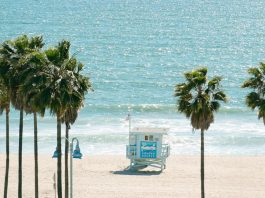
Cuteness is often deployed in contemporary visual culture as a disarming veneer—something that attracts attention, is broadly appealling and quietly conceals harsh truths beneath its polished surface. Fairy tales and toys like dollhouses employ the same strategy, serving as metaphorical devices that prepare children for the inequities and power structures of adult life. This symbolic logic defines the visual lexicon of Yvette Mayorga, a Chicago-based artist who has just transformed Times Square with her commission for Times Square Arts: a 30-foot-long kinetic pink carriage that appears to have rolled straight out of a fairytale. Beneath its candy-colored façade, adorned with Hello Kitty backpacks and lowrider gold rims, lies a far more complex story that confronts U.S. migration policies, feminine labor and the fractured illusion of the American Dream.
The monumental work marks the culmination of two years of development, a period during which both Mayorga’s practice and U.S. politics have evolved, rendering the project all the more poignant. The artist is a first-generation Mexican-American whose family migrated from Jalisco, and the commission is not only a milestone in her career but also a vital moment of visibility for the community she represents. “It feels even more important to have a piece like this in Times Square, such a heavily trafficked site visited by people from all over the world,” she told Observer before the unveiling.
“When I was invited to imagine a sculpture for that setting, I really wanted to play with the idea of Times Square as the ultimate symbolic site—a place so many people first think of when they picture the U.S. and especially New York. For tourists, it stands alongside other iconic American landmarks.” Mayorga sought to engage with that visibility and with the dense layers of commercial imagery that saturate the space and the values of contemporary America.


Camouflaging her work in a candy-pink aesthetic, Mayorga transforms cuteness and innocence into ingenious visual snares—accessible and inviting yet laden with stories of inequality and surveillance she has lived through. Beneath the sugary surface lies diasporic trauma and commentary on the underpaid labor of Latino communities in the United States.
Drawing on her mother’s work as a baker, Mayorga devised a singular technique: using cake nozzles and piping bags to sculpt acrylic paint. This process allows her to weave her family’s narrative into her art while, more broadly, addressing the condition of the Latino working class—so often tasked with strenuous yet poorly compensated labor—through a method that both mirrors and reimagines the artistry of confectionery work performed by her mother and other migrant women.
The fairytale references, especially the carriage, evoke childhood memories and conjure a more magical world, though for Mayorga, they are no escape from reality. “This is also a metaphor for life—happiness and grief happening at the same time,” she reflected. “I’ve always been around that, and I’ve learned to accept it as the reality of life. To stray from it makes us less human, right? These things will always move in tandem.”
Sitting with grief recently—anticipated grief, collective grief, all of it—pushed her toward deeper introspection, nurturing a new maturity that now informs and resonates through her work. At the same time, this archetypal and symbolic imagery transcends the present, serving as a reminder that history moves in cycles and that the ghosts of the past can easily return as the demons of the present if we fail to remain vigilant and allow memory to fade.


The image of the carriage carries multiple layers of meaning, but it first emerged when Mayorga learned that Times Square served as a carriage meeting point in its early days. Further inspiration came from the 19th-century Mexican carriages of the First Empire, which she encountered in 2018 at Chapultepec Castle in Mexico City, their interiors lavishly adorned with Louis XVI decorative motifs. The title of the work, Magic Grasshopper, references Chapultepec (which means “on the hill of the grasshopper”) and draws attention to a place that was once an Aztec settlement and later overtaken. “By combining this history with a carriage fitted with carousel horses carrying backpacks, I wanted to imagine an object that can transcend space and time, tying together histories of decadence, colonial legacy, and Latinx identity, while continuing the investigation and reclamation at the center of my practice,” she explained.
At the core of Mayorga’s aesthetic is a concept she coined, Latinxcoco, which fuses Latinx and Rococo sensibilities—Versailles-inspired grandeur entwined with Mexican symbolism and architecture. Her earliest encounters with Baroque and Rococo came through their Mexican iterations during childhood visits to her family’s hometown in Jalisco. As she recalls, she was particularly captivated by the Churrigueresque, or ultra-baroque, the Spanish Rococo style that emerged in the late 17th and early 18th Centuries and was later reimagined in Mexico. The style was intended to overwhelm the viewer with dense ornamentation like broken pediments, undulating cornices, reversed volutes, balustrades, stucco shells and garlands. Yet in Mexican hands, it evolved further, its exuberance amplified and infused with local symbols, transforming an imported language of domination into a vibrant expression of cultural resistance.


This choice carries an unmistakable allusion to the present. Rococo flourished amid excess and opulence, just before collapse and revolution. Likewise, today’s America faces an alarmingly widening economic divide, where the disappearance of any middle ground has deepened the chasm between the extremely wealthy and the poor—now on a global scale. History has shown where that trajectory can lead.
Placing such a message in Times Square—perhaps the ultimate emblem of America’s promise of prosperity through consumerism and media—only sharpens its edge. The carriage looks ready to embark on the so-called American Dream: suitcases strapped to the roof, horses outfitted with Hello Kitty backpacks, and a smiley-face flag fluttering with near-absurd optimism. Beneath it, gold-rimmed, tricked-out wheels turn slowly in an homage to lowrider culture rooted in Chicago’s Mexican-American communities, where Mayorga’s family settled after migrating from Jalisco and still lives today. Across the carriage’s body, painterly scenes of migration unfold, weaving European art-historical tropes with personal and collective narratives.
Yet Mayorga deliberately leaves interpretation open, creating an installation that, like fairy tales or cartoons, shifts meaning depending on who encounters it and how they read the evolving landscape of today’s Americas.
At this stage in her career, after numerous public commissions and gallery and museum exhibitions, Mayorga is acutely aware of the assumptions her work provokes through its pastel palette and seemingly innocent aesthetic. “I already create with that in mind, knowing there are so many different entry points,” she said. “With public work especially, that’s what excites me most: not everyone who sees it is ‘well versed’ in art history, but they can still experience it, and I hope it intuitively does something for them, makes an impact in some way.”
For this commission, scale itself was essential. “The scale is so massive it’s almost impossible to miss, whether you’re commuting to work or visiting New York for the first time. I hope even a passing glimpse catches someone’s eye and offers a moment of joy—just a small pause of color and playfulness in the middle of everything else going on.”




